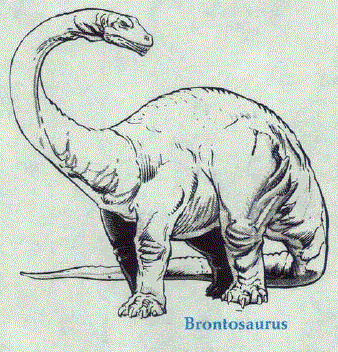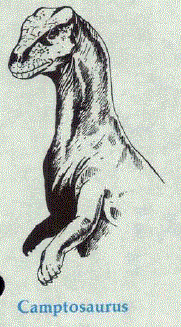| Anchisaurus | Brachiosaurus | Camarasaurus | Camptosaurus | Cetiosaurus | Dacentrurus | |
|---|---|---|---|---|---|---|
| Climate/Terrain: | Any land | Any swamp | Anyswamp | Any land | Any swamp | Any land |
| Frequency: | Common | Uncommon | Common | Common | Uncommon | Uncommon |
| Organization: | Herd | Solitary | Herd | Herd | Solitary | Herd |
| Activity Cycle: | Day | Day | Day | Day | Day | Day |
| Diet: | Herbivore | Herbivore | Herbivore | Herbivore | Herbivore | Herbivore |
| Intelligence: | Non- (0) | Non- (0) | Non- (O) | Non- (0) | Non-(0) | Non- (0) |
| Treasure: | Nil | Nil | Nil | Nil | Nil | Nil |
| Alignment: | Nil | Nil | Nil | Nil | Nil | Nil |
| No. Appearing: | 2-20 | 1-6 | 2-8 | 2-16 | 1-4 | 2-8 |
| Armor Class: | 7 | 5 | 6 | 7 | 6 | 3/6 |
| Movement: | 12 | 6 | 6 | 9 (stampede 18) | 6 | 9 |
| Hit Dice: | 2 | 36 | 20 | 1-3 | 24 | 10 |
| THAC0: | 16 | 5 | 5 | 1-2 HD: 19 3 HD: 17 | 5 | 11 |
| No. of Attacks: | 1 | 1 | 1 | 0 | 1 | 1 |
| Damage/Attack: | 1-4 | 5-20 | 3-12 | 0 | 3-18 | 2-16 |
| Special Attacks: | Nil | See below | See below | Stampede | Nil | Nil |
| Special Defenses: | Climbing | Nil | Nil | Nil | Nil | See below |
| Magic Resistance: | Nil | Nil | Nil | Nil | Nil | Nil |
| Size: | M (7' long) | G (75' long) | G (50' long) | H (20' long) | G (60' long) | H (15' long) |
| Morale: | Steady (11) | Steady (12) | Average (10) | Average (9) | Steady (12) | Steady (12) |
| XP Value: | 2,000 | 28,000 | 10,000 | 15-65 | 14,000 | 1,400 |
Anchisaurus
This bipedal herbivore feeds upright from time to time, but spends most of its time on all fours. If there is vegetation large enough nearby, it will climb to escape small predators. Its teeth are sharp enough to deliver retaliatory bites upon opponents, but the anchisaurus will not start a fight.
 Brachiosaurus
Brachiosaurus
The heaviest of all dinosaurs, this monster dwells in warm swamps and lakes. The brachiosaurus's long front feet are deadly- if it steps on something small, the giant beast inflicts 8d10 points of damage.
The brachiosaurus is the largest dinosaur in the family of sauropods. This great creature is the largest land animal known, for the length of 75 feet given above is an average- there are unverified reports that some relatives of the brachiosaurus are as large as 130 feet long. The brachiosaurus can easily reach the tops of trees with its 40-foot height, half of that being its long neck.
It weighs in at an ungainly 90 tons, three times as much as its relative, the brontosaurus. (A whale, the largest marine animal, is typically 100 feet long and 150 tons.) To support its great bulk, the brachiosaurus spends literally all of its waking hours eating. With its tiny brain, it is unlikely to notice interlopers in its range- but then who would be foolish enough to attack a brachiosaurus?
Camarasaurus
Yet another sauropod, this swamp-dwelling herbivore is small for its type. Its fearful nature causes it to live in herds with its fellows, but the creature still panics more easily than does a brontosaurus. Stepping or trampling damage is 3d10 points.
Despite being a sauropod, the camarasaurus tends to eat ferns and leaves of lower branches, so it does not compete for food with its larger cousins. Herds of camarasauri tend to migrate seasonally, so can be found almost anywhere, depending on the time of the year.
To help digest its food, the camarasaurus swallows rocks, which help grind vegetable matter in its large stomach, like a bird's gizzard. Presumably, valuable gems might be found in a camarasaurus's belly, but searching for one would be like looking for a needle in a haystack.
Camptosaurus
 This slow, exceptionally dumb iguanodont is easy prey for any hungry predator, typically too stupid to run until one of its number is killed. Anyone caught in a stampede of these creatures must roll a successful saving throw vs. death ray or be crushed to death. A herd consists of small, medium, and large individuals.
This slow, exceptionally dumb iguanodont is easy prey for any hungry predator, typically too stupid to run until one of its number is killed. Anyone caught in a stampede of these creatures must roll a successful saving throw vs. death ray or be crushed to death. A herd consists of small, medium, and large individuals.
Cetiosaurus
These huge plant-eaters dwell in lakes and marshes. Their heads are somewhat larger than other sauropods, such as the brachiosaurus, brontosaurus, and diplodocus. If they step on something small-such as a human-the cetiosaurus's 10 tons of bulk inflicts 4d10 points of damage.
Like its relatives, the cetiosaurus must eat vast quantities of plants to keep its weight up. The main reason that sauropods have such large bodies is that they are filled with stomach and intestines to process their dietary intake.
Dacentrurus
This creature looks like a stegosaurus with long, sharp spikes instead of plates along its back and tail. It is an aggressive defender, dwelling mainly in areas of heavy vegetation. When attacked, its active defense allows it a 75% probability of being AC 3. Attackers are also 25 % likely to have to suffer an attack resulting in 1d8 points damage when striking at this dinosaur's neck, back, or tail. The dacentrurus continually turns itself so that its lashing tail can strike opponents.
